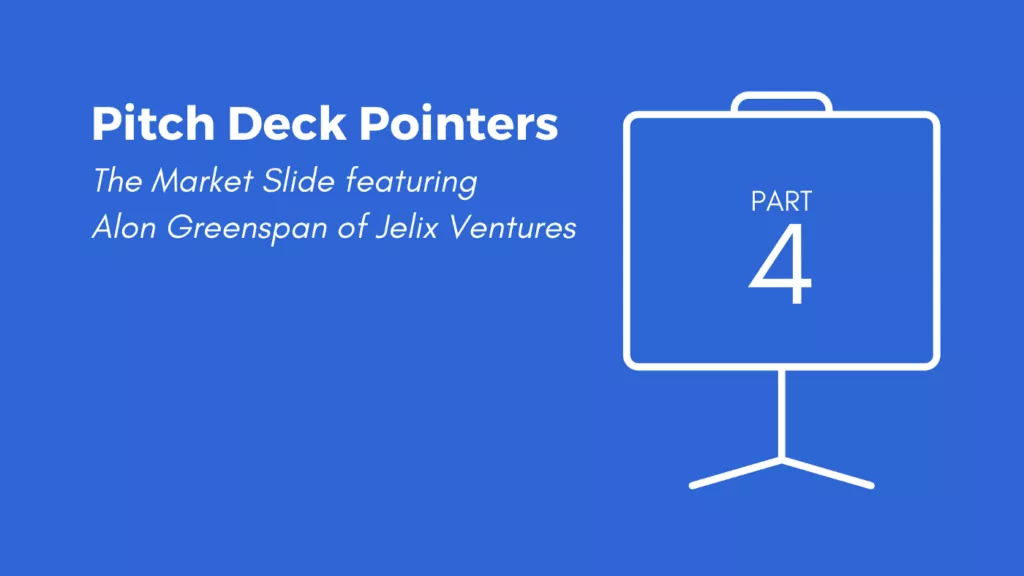Pitch Deck Pointers Part 4: The Market Slide
In the latest addition to our pitch deck guide series, Alon Greenspan of Jelix Ventures shares his advice for creating a market slide that will woo investors.

About Pitch Deck Pointers
Our mission at Innovation Bay is to support founders on their journey from idea to IPO. In the month of February, we’re focusing on helping founders learn about fundraising by breaking down a crucial fundraising tool: the pitch deck. Who better to get pitch deck feedback from than an investor? That’s why we’ve started our Pitch Deck Pointers series and recruited some of Australia’s top venture capitalists to share their advice for founders working on their pitch decks. If you’ve missed our previous instalments of the series, see:
- The Intro Slide featuring Sian Priest of Innovation Bay
- The Problem Slide featuring Emily Close of AirTree Ventures
- The Solution Slide featuring Hannah Field of Tempus Partners
Today, to dissect The Market Slide, we’re joined by Alon Greenspan, Investment Associate at Jelix Ventures, an early-stage VC firm investing in world-class Australian and New Zealand tech startups. Alon will break down the purpose of the market slide, highlight some common mistakes to avoid, and share his top pitch tips.
Meet the VC: Alon Greenspan of Jelix Ventures

I’m Alon Greenspan from Jelix Ventures. We invest in early-stage visionary and globally scalable startups, backed by innovative technology and led by extraordinary entrepreneurs. I spend my days meeting awesome people and helping them grow their businesses.
The Market Slide

The purpose of the market slide and why it’s important to an investor
The market slide is important because it helps us estimate what the future market/potential for a product or service could look like. We’re an early-stage VC— we invest early but seek high returns of our initial investment. So if the market size is small it might be hard for you to achieve the returns we are after and it will be difficult for us to justify an investment into your awesome venture. –AG
Common mistakes made on the market slide
I’d say a common mistake is exaggeration or miscalculation of the market. We often see founders relying on third party high level reports/estimations which may not reflect the real size of their addressable market. They may not take into consideration factors like competitors, pricing and specific market segments. I’d advise founders to try to (a) be as conservative as possible and (b) identify your target markets and size and back top-down calculations with bottom-up calculations. –AG
Top pitch tips for founders
1. Top-down calculation is good but bottom-up is better! Top-down is a good place to start but bottom-up can give us (and you!) a better understanding of the potential of your business given the level of granularity (various customer personas, competition, pricing and spend levels)
2. We like to see your market sizing calculations if possible. We are sector agnostic and you probably have more knowledge about your market so sharing your calculations will help us understand the thinking and inputs behind your numbers instead of relying solely on our numbers. –AG
Next up:
- Part 5. The Unfair Advantage Slide featuring Benjamin Chong of Right Click Capital
- Part 6. The Competition Slide featuring Hugh Bickerstaff of Investible
- Part 7. The Business Plan Slide featuring Kylie Frazer of Eleanor Venture
- Part 8. The Traction Slide featuring Dan Gavel of Black Sheep Capital
- Part 9. The Team Slide featuring Tip Piumsomboon of Blackbird Ventures
- Part 10. The Ask Slide featuring Georgina Turner of Tidal Ventures
Disclaimer: At the end of the day, this series is just a guide and should not be taken as gospel. Just as every business is unique, every slide deck should be unique. While the general order and number of slides we’ll use in the series is a good jumping-off point, perhaps a few more or fewer slides or a completely different sequence would better fit your company’s story.
For more fundraising advice, tune into our podcast Open the Pod Bay Doors. We interview startup investors and founders in the Australian tech ecosystem.